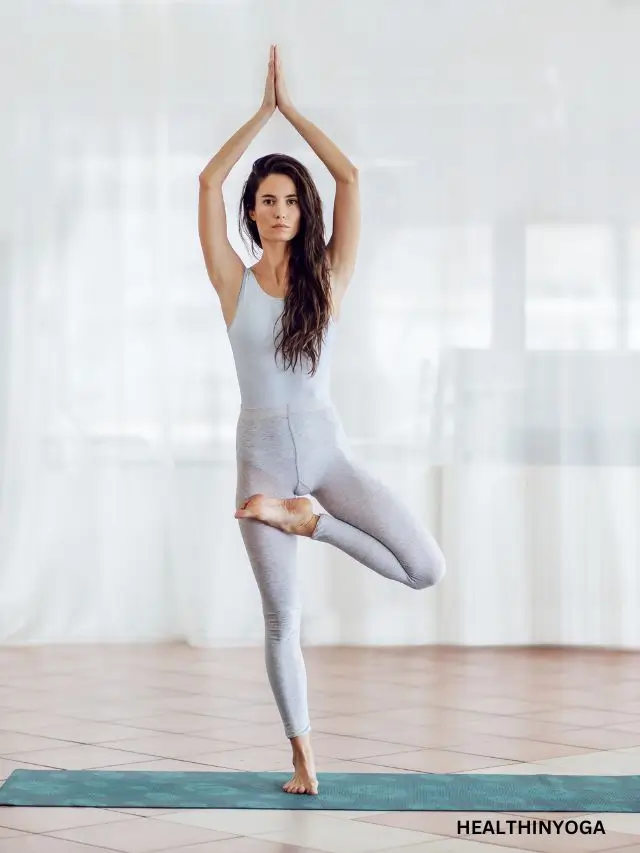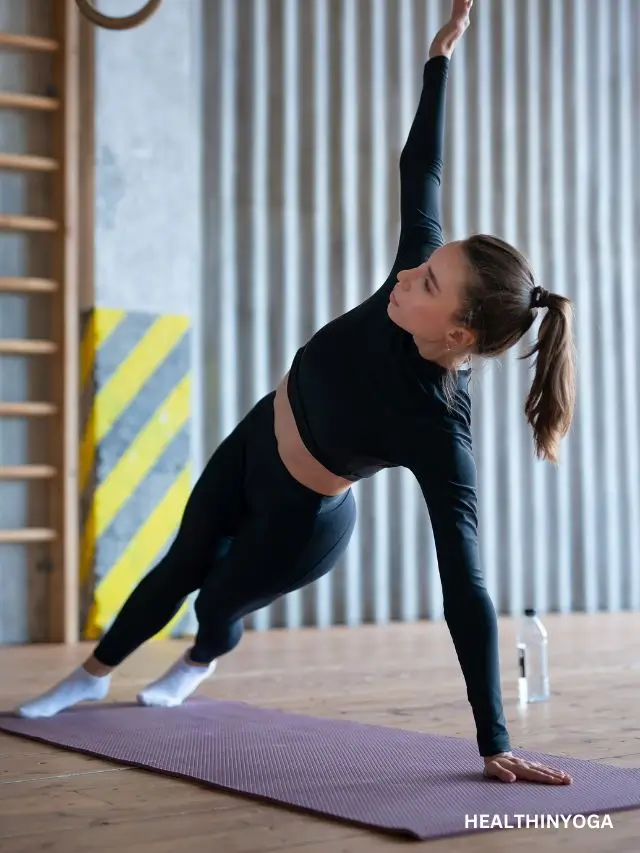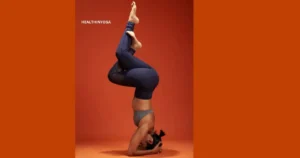Last updated on May 29th, 2024 at 12:21 pm
The regular traditional Tree Pose (Vrikshasna), offers multiple benefits to your physical & mental health well-being. Once you have mastered the tree pose, you can allow your body to delve into various variations to explore more challenges and deepen your practice. These variations of poses are modified, energetic, and more effective in improving core strength, balance, and flexibility.
Be ready to add more variation and challenges to your yoga routine.
In this article, we suggest two excellent Tree Pose Variations, Half Lotus Tree Pose (Ardha Padmasana Vriksasana) and Side Plank Tree Pose (Vrksana in Vasisthasana). These variations help you find balance and flexibility, they demand more concentration and engagement of muscles.
1. Half Lotus Tree Pose

Half lotus tree pose, is a one-legged standing pose, also known as Ardha Padma Vrksana. It is an advanced version of the tree pose. This pose is a blend of two yoga poses including tree pose and half lotus pose, double benefits of both poses.
It is an intermediate, a good hip opening posture in which one leg balances the whole body weight and the other makes a shape like the half lotus. A deeper practice helps in hip rotation, warm-up, and joint mobility.
Benefits Of Half Lotus Tree Pose
This pose has a bunch of benefits, regular practice of that pose improves posture, balance, and focus. Here are some benefits listed below
- Balance and tone the abdominal muscles.
- Help in opening the tight hip muscles.
- Reduce anxiety, tension, and negative thoughts.
- Good for joint mobility and health.
- Improve the health of reproductive organs and the digestive system.
- Increase confidence, focus, and concentration.
- Strengthen the legs, hips, and back muscles and lower the risk of hernia.
- Stimulates the nervous systems and lymphatic systems.
How To Do Half Lotus Tree Pose
Here is the step-by-step process of practicing the half lotus tree pose
- Stand straight in a mountain pose, arms at your sides and feet together.
- The feet should be firmly on the ground with the hips apart, to find more balance and stability.
- Inhale shifts your body weight on the left foot and balances the position.
- Raise the right foot bend the right knee up and put the right heel on the left thigh.
- Ensure the sole of your right foot is facing upward.
- Hold your right foot with the help of the left hand for support and to lengthen your spine.
- Bring your hand towards the center of the chest in a prayer position(Anjali Mudra).
- Stay in this posture for 20-30 seconds and keep breathing throughout the posture.
- When you want to release the pose, slowly lower your hand, straighten the right leg, and relax.
- Repeat the pose same with the left leg and try at least 3-4 times with each side.
Contraindication Of The Half Lotus Tree Pose
- Avoid practicing this pose, if you have recent knee, hips, and shoulder injuries.
- Avoid practicing if you experiencing headaches, low or high blood pressure, or dizziness.
- Pregnant women and senior citizens should avoid practicing this pose because it requires a lot of balance and flexibility.
- Persons with body weakness, brittle bone, weak muscles, and vertigo issues, do not practice this pose.
2. Side Plank Tree Pose

The side plank tree pose is a modified version of the traditional tree pose, in yoga known as (Vrksaana In Vasisthasana). It is a challenging and fun variation of the tree pose, that helps to strengthen the oblique muscles and arms.
This pose is a combination of two poses one is the tree pose and the other is the plank pose. This focus on core strength and balance will help yogi to make their practice more challenging and try something beyond the limitations. This demands more stamina, strength, and balance to add more effective practices and improve alignment, balance, stability, and concentration.
Benefits Of The Sise Plank Tree Pose
This pose is a coordination of the core, arms, hips, and thigh, a full body workout. It is an especially beneficial pose for runners, sports persons, and athletes. This helps improve balance stability and adds more difficulties to your routine.
- Strengthens the core and arm muscles, making them strong and healthy.
- Improve a sense of mindfulness and calm the mind.
- Stimulates the Manipura & Anahata Chakras and connects the body, mind, and soul.
- Increase the stamina of runners, athletes, and sports persons.
- Open muscles of the hips, and glutes and improve balance and posture.
- Boosts self-confidence and encourages inner awareness and mindfulness.
How To Do Side Plank Tree Pose
Here are the step-by-step instructions given below for practice side plank tree pose
- Firstly being in the downward-facing dog position, your hand, legs, shoulders, and knees should be apart.
- Lift your hips back straighten the legs and make a shape like a V.
- Engage your core muscles and firmly press the heels of the feet on the ground.
- Shift your body weight on the right hand and rotate your body towards the right foot.
- Lengthen the spine and body should be straight and aligned.
- Now lift your arms facing toward the ceiling and look up to your arms.
- Inhale and lift the left leg, bend your knees slowly and bring it closer to your chest.
- Place the sole of the left foot near the right thigh as if you are comfortable.
- Stay in this position for 3-5 breaths maintain strong core muscles and keep your hips muscles tuck in.
- Release the pose and relax, repeat the same pose with the other side.
Contraindication Of The Side Plank Tree Pose
Here are some limitations and risk factors of this pose
- Avoid practicing, during the wrists, elbows, shoulders, neck, and hips injury, as it may cause strain in the muscles.
- Persons recovering from recent abdominal surgery should avoid performing this pose.
- If you have an issue of vertigo, dizziness, high BP, or arthritis avoid doing this pose.
- Pregnant women and senior citizens avoid practicing this pose due to the need for lots of core strength and stamina.
- Persons with herniated disc or carpal tunnel syndrome, and bursitis avoid performing this yoga pose.
Other Variations Of The Tree Pose
- Tree Pose Challenging Variation For Arms (Windy Tree Pose& Valcano Arms)
- Beginner Tree Pose Chair ( To Find More Balance And Stability)
Conclusion
Tree pose is a tradition, yoga pose is a basic standing balancing yoga posture and a part of hath yoga. It comes with a lot of variations and modifications according to the ability and stamina. There are a variety of modified variations that add more difficulties to challenges yourself.
These poses improve flexibility, and muscle strength and tone the body, it is incredibly beneficial for overall health.
The Half Lotus tree pose and The Side plank tree pose are the merger of the tree pose with the other yoga poses and an effective, playful way to challenge the body beyond the boundaries. So, if you are looking for maximum transformation and stability then you must try and add these effective variations in your yoga routine.
Tree pose volcano arms pose is a great variation of the Virkasana with the help of arms, represents volcanic power with the arms and challenges your balance, improving your stability.
If you have any questions or suggestions, please leave a comment. We will pleased to answer all your queries. Thank you.

Honey is a certified yoga instructor with training from Patanjali Yogpeeth, Haridwar. With four years of dedicated teaching experience, she specializes in using yoga to improve spinal health, build core strength, and help people find relief from chronic pain. Her mission is to make the transformative power of yoga accessible to everyone.




